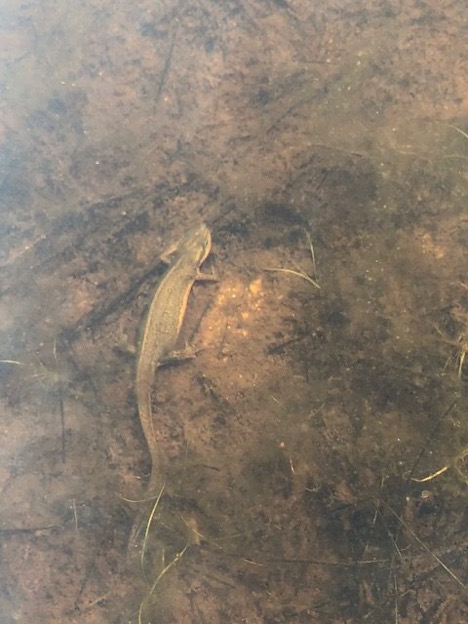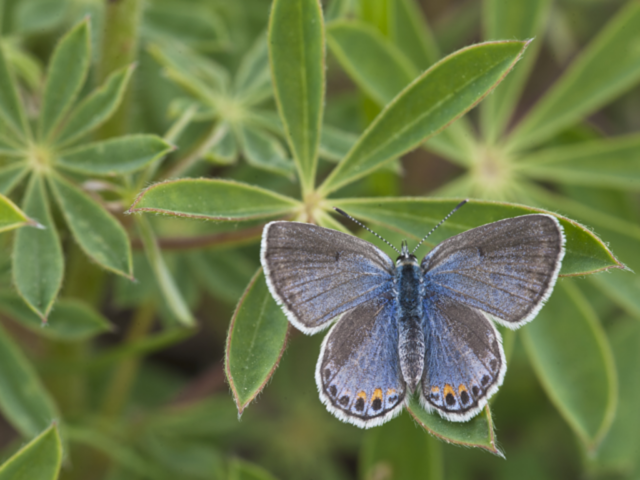David Bailey, SCA Interpretive Ranger
A state symbol can hold great meaning to a state. Many of them are chosen because they represent unusual and interesting items found within the state. New Hampshire is no different.
As an Interpretive Ranger one of my more popular programs involve talking about some of these symbols. Here are some of my favorites to talk about.
Red Spotted Newt


New England is home to four subspecies of the Eastern Newt; the Red-Spotted Newt, the Broken-Striped Newt, the Central Newt, and the Peninsula Newt. The Red-Spotted Newt is the only Newt commonly found in New Hampshire.
The Eastern Newt has three stages to life. The first an aquatic larval stage. When the newt hatches for the egg sack it has a yellowish-brown, olive or brown skin. It also has gills and a laterally flattened tail. For the Red Spotted Newt this takes places mostly in vernal pools or seasonal pools that fill with snow melt every spring.
The second stage for the eastern newt is the red eft. The newt will lose its gills and come onto land. The red eft will grow to be about three inches long and becomes a bright reddish-orange color. Having this bright color serves as a warning to other animals that it is very toxic to eat and that it should not be bothered. At this phase the red-spotted newt has black-bordered orange-red spots. It is also not required to be by a body of water during this phase. The red efts can be found in moist deciduous and coniferous forests. They have a diet consisting mostly of springtails and other insects.
At its final phase the newt has yellowish-brown, olive green, or brown on its upperside, and it has a yellow belly with black spots. Its tail is more flattened than the tail of the red eft. Adult eastern newts are 2½-5½ inches in length. At this phase the newt can be found living in ponds, lakes, streams and marshes. Their diet is made up of insects, worms, fish eggs, small crustaceans and amphibians. They have a life spend of about 15 years.
NOTE- What is the different between a newt and a salamander?
Newts have webbed feet and a paddle like tail that helps with swimming. Their skin is rough and is bumpy. The salamander has toes that help with digging in soil and has a round tail. Their skin is wet, slick and shiny.
Karner Blue


The Karner Blue is about one inch across and has a small color change between male and female. The male will be dark blue and have a black border around its wings while the female has duller blue wings with a brown or gray border around the wings.
The Karner Blue also has a very short life cycle. Twice a year, once around April and once around mid-August their eggs are hatched. The eggs are laid on or near the wild lupine so when the caterpillars hatch, they can begin to feed. After about three to four weeks of feeding the caterpillars will form a chrysalis and pupate for 8 to 11 days. When they come out of their chrysalis, they wait about 45 minutes for their wings to dry before they can fly. The butterflies are now able to eat the nectar of flowers like the rock cress, raspberry, goldenrod, and butterfly weed. The Karner Blue will only live for a week or two before mating. The first generation will make the eggs that hatch during the end of summer while the second generation will lay eggs that will dormant until the spring.
This small butterfly was once found from Maine to Minnesota but is now only found in small numbers in eight states and Ontario, Canada. The only location that these butterflies are found with in New Hampshire is the Concord Pine Barrens in East Concord.
The Karner Blues population began to decline around the 1970’s and 1980’s and this is partly due to the loss of key habitat. When in its larva phase the Karner Blue will only eat wild lupine which is starting to have a hard time growing due to thick tree growth. The wild lupine also requires a dry and sandy soil to grow. Due to fire suppression, areas that would routinely be cleared have been grown over making it hard for the wild lupine to grow. The only spaces that are regularly cleared to meet these needs are roads, powerlines, and airport runways.
While the Karner Blue is endangered there are many efforts going to help save them. One such place in New Hampshire is located at the Karner Blue Butterfly Easement at New Hampshire Army National Guard base in the city of Concord. Since 2000 the site has released 35,000 Karnar Blues into the local area. More information about the program can be found here at the US Fish and Wildlife website.
References
Red-Spotted Newt
Karner Blue
https://www.fws.gov/story/karner-blue-butterfly-recovery-new-hampshire
https://www.nature.org/en-us/get-involved/how-to-help/animals-we-protect/karner-blue-butterfly/

